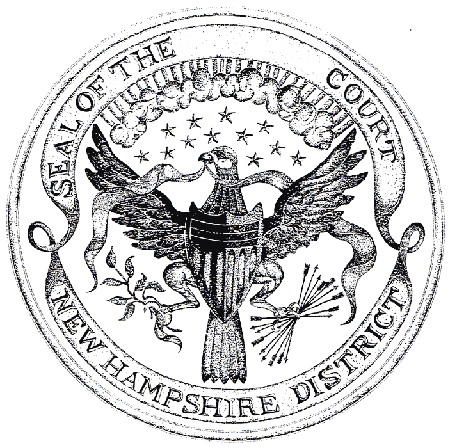26. The District of New Hampshire
Located: 1st floor, hallway at courthouse and federal building link
Prints in courthouse exhibit: District’s original seal
The Judiciary Act of 1789 established New Hampshire as one of the original thirteen judicial districts of our new nation. This display and accompanying essays in four parts (exhibits 26a - 26d) will focus on the development of both the District and Circuit courts in the District of New Hampshire which originally held session in Portsmouth and Exeter, before moving to Concord in 1881.
This District’s early history includes a Revolutionary War hero who served with and was later nominated by George Washington as our first Article III Judge, a judge who became the focus of a squabble between the nation's original two political parties, and an influential Civil War Senator who served as our fifth Article III Judge. After nearly 100 years of sharing courthouses with local and state courts, the Federal Court was housed in two different locations in Concord before finally occupying our current modern facility, named for United States Senator Warren B. Rudman in 1997.
This exhibit concludes with a description of the current structure of today's federal judiciary.
The four parts in sequential order:
- 26a. The Establishment of the Fedral Judiciary
- 26b. "One...to be Called New Hampshire District"
- 26c. Places of Holding Court: Courthouses of the New Hampshire District
- 26d. Today's Federal Judiciary

The Great Seal of the United States
The Great Seal of the United States is used to authenticate certain documents issued by the federal government. The term “Great Seal” is used both for the physical seal itself, which is kept by the Secretary of State, and more commonly for the design impressed upon it.
On July 4, 1776, the same day our nation declared independence from Great Britain, the Continental Congress established a committee to design an official seal. The United States needed a symbol of sovereignty by which to formalize and seal international treaties and transactions, as was typical for nations during that period. It took six years, three committees, and the contributions of fourteen men, including some of our nation’s most visionary founders, before the Congress finally accepted the initial design.
As a cornerstone of nationhood and a carefully crafted message to the world, the Great Seal symbolically proclaimed the guiding principles of these United States. An eagle signifying strength, an olive branch for peace, arrows for defense, and thirteen stars representing the original thirteen states are among the most obvious symbolic features. The phrase “E Pluribus Unum” (“Out of Many, One”) gave clear emphasis to the circumstances of the young nation’s formation and its name: the United States of America.
Over time, the metallic die that embosses the seal’s design into documents degrades and must be replaced. The Great Seal was redesigned and engraved four different times in its first one hundred years. Each successive designer/engraver was given some artistic freedom to make improvements, subject to congressional approval. While the overall design remained basically the same, modifications were made to literally every element of the seal. For example, the eagle was changed to a bald eagle, the crest was removed and the eagle made more robust, its wings were extended and feathers sharpened. In 1885, the cloud surrounding the constellation was made a complete circle. The quality of the 1885 design put an end to the constant modifications of the seal, as the three subsequent versions of the die were almost identical. The seventh and current die of the Great Seal was made in 1986.
The Seal for the Judicial District of New Hampshire
In 1984, the Clerk of Court discovered an aged wax impression of New Hampshire’s original district seal at the bottom of a box retrieved from the National Archives. The precise origin of this fortuitous find remains a subject for further research.
During the nation’s first century, a wide variety of official and unofficial emblazonments for governmental entities were employed, but none identical to New Hampshire’s District Seal. The closest known version was created by Philadelphia engraver James Trenchard, whose several articles in the Columbia Magazine in 1786 included full-page illustrations of his design. That time period corresponds to the date of the court records found in the box containing New Hampshire’s wax impression. It is speculated that a local artisan and engraver may have used Trenchard’s unofficial version as a model. One unique feature of New Hampshire’s district seal is the space left blank for the Clerk of Court to hand-write which specific court, Circuit or District, was issuing the authenticated document. (See Exhibit # 26(b), “One to be Called … New Hampshire District”.)







